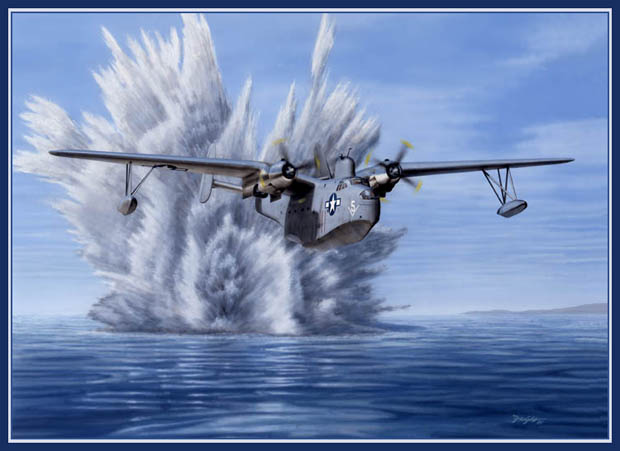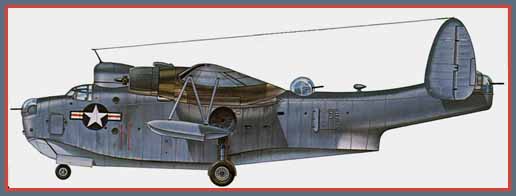













"P-Boat: One, U-Boat: Nothing" An Original Painting by Don Feight
The current active VP-45 evolved from the original VP-205 which was established at Norfolk on 1 November 1942 - over 75 years ago. From then until 24 May 1943, the Commanding Officer was LCDR Arthur S. Hill of New York, NY. He was followed in order by: LCDR Malcom C. McGrath of Norfolk, VA, to 1 October 1943; LCDR Robert S. Null of Rustin, LA, to 23 April 1944; LCDR George B. Cattermole of Hamburg, PA, to 9 October 1944; LCDR Herbert E. Hanset of Seattle, WA, to 17 November 1945; LCDR Norman K. Brady of Sanborn, IA, to after 1 January 1947.
During this period the squadron was very active, and moved from one war zone to another in both the Atlantic and Pacific Ocean areas. The chronology of transfers from one command to another tells the story. Until 1 February 1943 the squadron was assigned to Commander Transition Training Squadron, Atlantic, when it was then transferred to Commander Fleet Air Wing Eleven and was based at NAS Trinidad from 2 June 1943 until 7 July 1944, hense it was transferred to NAS Guantanamo, Cuba. On 19 September the squadron changed operational control (OPCON) to COMFAIRWING Five and moved to NAS Norfolk, but not for long. On 1 November it moved to NAAS Harvey Point, NC and on 28 November came under OPCON of COMFAIRWING Fourteen while it transferred across country to NAS San Diego, CA. On 1 December 1944 the new home base was NAS Alameda, CA under OPCON of COMFAIRWING Eight. Four days before Christmas, on 21 December 1944, the squadron flew to its new base at NAS Kaneohe, Oahu and reported to COMFAIRWING Two.
From 1 November 1942 to 1 February 1943 the squadron owned only two PBM-3’s and one PBM-3C. The inventory doubled to six PBM-3C’s while it was in training until 2 June 1943. From 2 June 1943 until 19 September 1944 the squadron averaged twelve PBM-3S’s, and lost three to enemy action against submarines. From 17 October 1944 to 31 December 1944 fifteen PBM-5’s were assigned and delivered to the squadron.
On 10 June 1943, eight days after arriving at NAS Trinidad, the squadron lost its first plane and crew to suspected enemy action. LTJG O. W. Haenal with two other officers and eight enlisted men took off from Trinidad on an assigned daylight mission, and was never heard from. Radio silence had been ordered; pursuant to such order, no "out" report was sent, and no other word was received from the plane. A three-day search instituted when the plane failed to return at the expected time provided no trace of the plane or crew, and no clue as to their fate.
The second plane lost was in charge of LTJG Clifford C. Cox, and carried three other officers and a crew of eight enlisted. On the night of August 2 the flight took off, and at 0025Q the following message from the plane was sent as it prepared to attack: "SIGHTED SUB. MAKING ATTACK POSITION 1133 5405 TIME 0025 QUEEN." That was the last contact with the plane. No trace of plane or crew was found, and it was presumed the plane had been shot down.
The third loss occurred on 6 August when LT Anthony R. Matuski, with two other officers and eight enlisted crew took off from Trinidad on an ASW sweep and made contact with the enemy. At 1320Q the base received a message that the plane was attacking a submarine, and five minutes later a second message gave his position as 12-54N 64-34W, stating that the sub was crippled with no damage to the plane. Twelve minutes later a message came in saying, "DAMAGED FIRE", which was the final word. Planes sent to the position sank the submarine, but no trace of the plane and crew that had drawn first blood from the sunken sub was ever found. Survivors from the sunken sub reported setting two aircraft on fire, one of which crashed within their view. The second plane (a VP-205 plane flown by PPC LT Crockett and crew from VP-204) was able to extinguish its fire and returned to join the action that sank the sub.

Just prior to this, on 31 July at 2126Q, LT H. B. Lawrence sighted a submarine on the surface at 09-35N 57-29 W and pressed home an attack in the face of heavy fire. The sub was forced to submerge, but surfaced an hour later, and again was engaged with an exchange of fire. After the final bomb drop by the plane, the anti-aircraft fire ceased abruptly. No other assessment of the attack is available, but it was believed the sub suffered some personnel casualties.
Patrol Squadron 205 returned to Norfolk on 19 September 1944, the planes were retired from active service, and the personnel scattered for rehabilitation leave. Then the squadron was redesignated Patrol Bombing Squadron 205 (VPB-205). When the personnel returned, fifteen new PBM-5’s were assigned and refresher training was the order of the day in preparation for transfer to the Pacific Fleet.
The squadron arrived in the Pacific too late to engage in any enemy action, but transferred to NAB Tanapag, Sampan on 1 April 1945 and was under the command of COMFAIRWING ONE for the transfer, then Task Unit 94.1.2 (CDR George S. James, CO USS CASTLE ROCK) operating under COMFAIRWING EIGHTEEN. On 25 August the squadron moved from Saipan to Chimu Wan, Okinawa, where it was based aboard USS ST. GEORGE, and attached to Task Unit 95.9.6 (CAPT Robert G. Armstrong, Commanding Officer USS ST. GEORGE) operating under COMFAIRWING ONE. Since the war was over, flights were surveillance types along the coasts of China, Korea and Japan.
On 23 September, the squadron moved to Wakayama, Japan, still based aboard USS ST.GEORGE and under COMFAIRWING ONE, and prepared to make the long trek back home. Before leaving Japan, though, one more plane and crew were lost to undetermined causes. On 2 October 1945 LT Gilbert Delos Lizer, with Ensign Kazimer Olenski as co-pilot, departed at 0702 on a routine surveillance flight with passengers RADM W. D. Sample and CAPT Charles C. McDonald, and a crew of seven enlisted. At 0755 the plane was observed heading away from Kobe. That was the last contact with the plane. After eleven days of search all results were negative and it was called off. The accident site was discovered in November 1948, on Honshu, Japan, and the bodies were buried at Arlington Cemetary in a common grave. On 12 November 1945 the squadron departed Japan for Norfolk via Saipan, Ebeye, Majuro, Johnston Island, Kaneohe, Alameda, San Diego, Fort Worth, and Pensacola. It arrived at Norfolk on 13 December 1945. LCDR N. K. Brady relieved LCDR Hanset on 17 November while the squadron was enroute to CONUS.
Aircraft were overhauled, crews departed on leave (many were discharged) and reorganization and training became the norm. On 12 April 1946 the squadron's home port was changed to NAF Bermuda under COMFAIRWING FIVE, and had 9 PBM-5’s assigned to it. On 15 May the squadron was redesignated from VPB-205 to VP-205, and on 15 November 1946 from VP-205 to VP-MS-5 (the MS = Medium Seaplane). CDR W. L. Brantley became the Commanding Officer in February of 1947 and was relieved by LCDR W. M. Arnold in June of 1948 - and was himself relieved that same month by CDR O. O. Dean.

On 1 September 1948 the squadron was redesignated VP-45, and has remained so to this date. VP-45 changed homeports in early 1950 to Norfolk, Virginia, and in 1951 the squadron, with twelve PBMs, was moved to the Naval Station Coco Solo, Canal Zone (Atlantic side of the Isthmus). The Commanding Officer after CDR O. O. Dean, who was relieved in December 1949, was CDR T. G. White, who commanded to September 1951. CDR W. W. Bemis served as Commanding Officer to September 1952, and was relieved by CDR T. R. Perry.
Send questions, comments or suggestions regarding this website to: vp45association.org
Copyright © 2005 PATRON FOUR FIVE ASSOCIATION